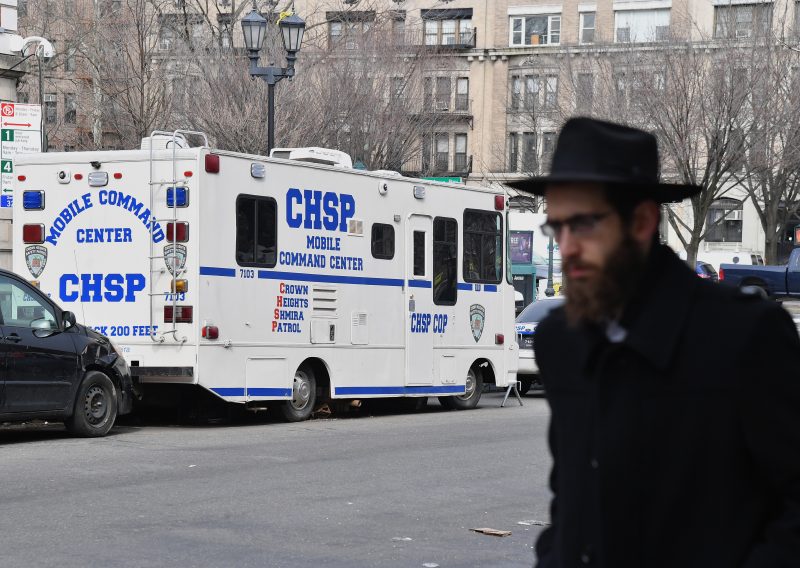New York community seeks cohesion after anti-Semitic attacks
A member of the Hasidic Jewish community in New York’s Crown Heights, where a spat of anti-Semitic attacks occurred (Angela Weiss)
New York (AFP) – Residents of Crown Heights, a diverse New York neighborhood far from Manhattan’s skyscrapers, are trying to understand a spate of anti-Semitic attacks that has brought back painful memories.
In recent months, several people wearing the type of black clothing and hats associated with the Orthodox Jewish community have been viciously assaulted — sometimes in broad daylight.
So far this year, complaints of anti-Semitic crimes have soared by 71 percent in New York, compounding a 23 percent increase in 2018.
The assaults have most impacted Crown Heights, and Borough Park to the southwest of Brooklyn.
Most of the alleged perpetrators have been arrested and the police have stepped up patrols, but the violence marks a troubling development — and for many locals harkens back to a difficult time.
In 1991, tensions between the Jewish and African American communities boiled over, erupting into America’s only anti-Semitic riot and rocking Crown Heights for three days.
The riots exploded after one of the cars in a motorcade transporting Rabbi Menachem Schneerson, head of the Crown Heights-based Chabad-Lubavitch movement, accidently crashed into two black children.
One died and the other was seriously injured, and in the ensuing violence a Jewish student was fatally stabbed by a black teen.
The riots were a culmination of decades of two communities living alongside but separate from each other.
In the aftermath, community leaders, activists and organizers came together to try to heal the rift.
“In 1991, we were like two ships passing each other in the night,” said Richard Green, who heads the Crown Heights Youth Collective.
Representatives from the two communities hustled and began outreach — especially with the younger residents — in a long-term effort to build trust.
“It was amazing the way that people learned about each other,” Green said.
It was “no longer this ‘we or them.’ It’s us,” he added, but now that “kind of fell off.”
The Orthodox Jewish community began arriving in Crown Heights in large numbers at the start of the 1940s.
The black population came up from the southern United States, as well as the Caribbean, during the 1960s.
In the last few years, communication between different communities has dwindled, Green said.
“We don’t communicate like we used to, and that’s what’s very needed right now,” he said.
– ‘Lack of understanding’ –
Rabbi Eli Cohen, director of the Crown Heights Jewish Community Council, is trying to change that.
Following the recent attacks, he started visiting local schools with Geoffrey Davis, an African-American community leader.
The goal was “to listen and to talk. To see if there’s any conversation that’s feeding this trend,” Cohen said, noting they wanted to “send a message to the kids that we’re all New York citizens living together.”
The pupils spoke about their differences, some of the pressures of living in the community and the “lack of understanding of people’s different customs,” Cohen said.
Local artist Rusty Zimmerman is working to forge closer ties too. He has started a project, similar to one he did in 2016, where he paints portraits of community members while interviewing them.
This time, he wants to paint pictures of the victims of the recent attacks — and has asked the police if he can paint their attackers too.
– ‘We have the solutions’ –
Almost 30 years after the unrest, New York is a very different city and Crown Heights has transformed, attracting a new generation of hip young residents.
But in today’s polarized America, the context has also changed, with the internet and social media acting as lightning rods for anti-Semitism and extreme voices.
New York Mayor Bill de Blasio has blamed President Donald Trump for an “atmosphere of hate” in America.
In October, a man shot and killed 11 people in a Pittsburgh synagogue in what was the worst anti-Semitic attack in recent US history.
“It’s a different world. It’s a different battlefield,” said Rabbi Shea Hecht, chairman of the National Committee for the Furtherance of Jewish Education, which offers religious education to Jewish children in public schools.
Still, he thought the recent attacks were not part of “an organized anti-Semitic wave.”
“I do not believe that the attacks particularly the last ones on the streets are organized in any way,” he said.
“There have been a lot of fluctuations in 25 years,” he added.
Green, who leads the Crown Heights Youth Collective, said things are not as bad as they could be and noted that the community has the tools it needs.
“We have the solutions already,” he said.
Disclaimer: This story is published from a syndicated feed. Siliconeer does not assume any liability for the above story. Validity of the above story is for 7 Days from original date of publishing. Content copyright AFP.


